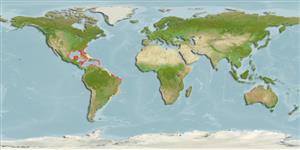Common names from other countries
Environment: milieu / climate zone / depth range / distribution range
Écologie
Récifal; saumâtre; profondeur 2 - 76 m (Ref. 108813). Tropical
Western Atlantic: Caribbean and Gulf of Mexico.
Length at first maturity / Taille / Poids / Âge
Maturity: Lm ? range ? - ? cm Max length : 5.0 cm OT mâle / non sexé; (Ref. 415)
Description synthétique
Morphologie
Thick encrusting; 1 - 5 cm to massive amorphous. Black to dark brown or tan externally on parts unexposed to light, tan internally. Tough, firm, and cartilaginous (Ref. 415).
Maximum thickness: 5 cm (Ref. 415). Occasionally found on mangrove roots and peat banks. Common on reefs and lagoons (Ref. 415). Found on rocky substrates (Ref. 83912). Inhabits seagrasses, mangroves, coralline algae reefs, algal nodules, lower mesophotic and heavily silted reefs (Ref. 128739).
Life cycle and mating behavior
Maturité | Reproduction | Frai | Œufs | Fécondité | Larves
Members of the class Demospongiae are hermaphroditic. Life cycle: The zygote develops into parenchymella larva (free-swimming) before settling down on a substrate where it grows into a young sponge.
Collin, R., M.C. Díaz, J. Norenburg, R.M. Rocha, J.A. Sánchez, M. Schulze, A. Schwartz and A. Valdés. 2005. (Ref. 415)
Statut dans la liste rouge de l'IUCN (Ref. 130435)
statut CITES (Ref. 108899)
Not Evaluated
Not Evaluated
Utilisations par l'homme
| FishSource |
Outils
Plus d'informations
Taille/ÂgeCroissanceLongueur-poidsLongueur-longueurMorphologieLarvesAbondance
Sources Internet
Estimates based on models
Preferred temperature
(Ref.
115969): 23 - 28, mean 26.1 (based on 296 cells).
Vulnérabilité
Low vulnerability (10 of 100).
Catégorie de prix
Unknown.
